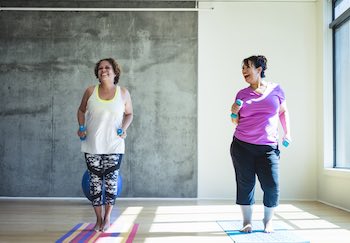
New year + new beginnings + new goals = New Year’s resolutions. For most of us, our resolution list includes exercise and losing weight. And the resolutions get us motivated. But even though every provider supports positive change, some worry that a New Year’s goal can lead to over-exercising and injury.
Why Is Over-Exercising A Concern?
With the new year, it feels like we get to reset the clock and start over, so the motivation is higher than normal. For people who don’t exercise regularly or who have a low activity level, the sudden transition and over-exercising is a recipe for injury or burnout.
David Hryvniak, MD, sees this frequently at the UVA Runner’s Clinic, as local people use the annual Charlottesville 10 Miler race in March as a motivation to start running. Hryvniak is board certified in sports medicine and a competitive runner himself so he understands the importance of not over doing it. But if you don’t follow a gradual plan for training or exercising, then you increase your risk of injuries and stress fractures.
How to Avoid Over-Exercising & Injury
Get Rest
Taking a day off or “rest days” are important to allow your body to heal. Also, it’s beneficial to switch up your activity, such as going on a hike, biking, trying cross-fit, or any other form of exercise. Changing your exercise up allows your body to strengthen other muscle groups.
Also, Hryvniak suggests stretching after your workout or at least warm-up. It’s never a good idea to stretch cold muscles. Planks or bridges are great core and glute exercises that can help with the prevention of injuries.
Drink Water
And don’t forget to stay hydrated. Drink when thirsty is a good rule of thumb, but Hryvniak recommends:
- A cup of water 1 – 2 hours before exercising
- A cup of water for every 30 – 45 minutes of exercise just completed
- Gatorade and sports drinks are helpful if you’re exercising for over an hour or in high temperatures
The goal is to replenish your electrolytes.
Over-hydrating can be an issue too. When you drink too much water, you begin to dilute the amount of salt and electrolytes in your body and this can be life-threatening.
Worrisome Signs of Post-Exercise Pain
We’ve all been guilty of saying, “oh, it’ll go away or get better soon,” but sometimes the pain doesn’t. So, when do you need to worry?
Soreness
After a workout or run, you should expect soreness. While the amount varies between each person, you can expect the pain to peak within 24 – 48 hours.
Well, if you experience soreness longer than normal and pain persists for a week or two, that’s a good sign that something is wrong.
You should also pay attention to:
- Pain at night, especially in legs
- Not sleeping well or experience overtraining syndrome symptoms
- Resting heart rate increases
- Losing motivation
Maybe you’re limping, or you’ve changed the way you walk or run because something hurts. These are red flags. You should visit your provider.
Common Injuries from Over-Exercise
Most people who over-exercise end up with tendinitis, an inflammation in the tissue connecting muscle to bone. But for those who ignore this pain, it can turn into a stress fracture, where the bone starts to break down. Luckily, most stress fractures heal pretty well on their own if you stop some activities and allow the injured area to rest. Providers will typically recommend 6 – 8 weeks of rest. More serious injuries will require a boot or crutches.
Overtraining syndrome is another concern with over-exercising. It affects both your mental and physical wellbeing. You’ll experience fatigue, constant soreness, a decrease in motivation as well as in exercise performance.
Life With An Exercise Injury
Depending on the injury, if running was the issue, then Hryvniak recommends a low-impact workout, such as using an elliptical or stationary bike while recovering. At the Runner’s Clinic, providers work with patients to improve their strength or recover from an injury. Hryvniak sees patients from young children to people in their 90’s. The goal is to keep people active and healthy.
Hryvniak recommends the “10% rule,” where you increase your exercise routine by 10% each week. So, if you’re used to walking or running 2 miles, adding a quarter mile each week gives you a gradual and safe exercise plan.
Concerns With Other Healthy Resolutions
Exercise and diet go hand-in-hand, which is very important, but you must be careful or you could do more harm.
The Cost of Cutting Calories
If you’re cutting calories to lose weight, be mindful of how much you’re limiting yourself, or you’ll increase your risk of injury. Stress fractures are more common in females without the proper calorie intake. Your body needs calories. So, when you deprive it of too many calories, your body goes to the muscles and bones to find energy.
Is The Pain Not Going Away?
It’s time to visit the Runner’s Clinic for an evaluation and recovery recommendations.
Also, females can experience missing their period as their body is trying to save energy when calories are too low. Instead of cutting calories, make healthy choices and increase caloric intake while exercising. Keep in mind, Dwayne, “The Rock” Johnson, eats up to 5,000 calories a day due to his extreme workout routine.
Don’t Ditch Dairy
Another concern, whether it’s due to an intolerance or choice, is when people avoid dairy products to lose weight. No, dairy is not ideal while exercising. Dairy gives your body an excellent source of vitamin D and calcium plus healthy fats and protein for bone health.
If you’re on a non-dairy diet, get creative to find ways to get these vitamins in your body. While evaluating patients, Hryvniak will ask if they drink milk or eat dairy products. If not, they’ll help you find other sources or supplements, but vitamins are better absorbed when eaten.
For 2020, set a realistic goal, eat healthy, listen to your body and find an exercise plan that works best for you. Exercise is not a one-size-fits-all solution. Everyone is different.
